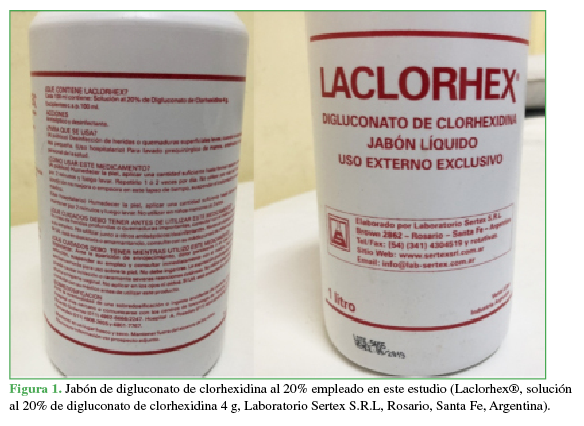Use of chlorhexidine in wound healing and granulation tissue formation
Main Article Content
Abstract
Introduction: Wounds with dressing defects pose a great challenge when choosing a good treatment that may reduce the risk of infection and promote granulation tissue formation.
Objective: To demonstrate the usefulness of chlorhexidine digluconate (CHG) for granulation tissue formation.
Materials and methods: Eighteen wounds (16 patients) that met the inclusion criteria were included. Wound cleansing was performed in outpatients with 20% CHG-impregnated cloths every 48-72 h, until the proper tissue granulation was achieved. Photographs of the clinical evolution of the wounds were taken.
Results: The adequate wound granulation mean was of 9.2 days (4-25 days) regardless of wound size or presence of comorbidities. There were no clinical signs of infection in any wound during the healing period.
Conclusions: CHG treatment is an appropriate method to be considered for outpatient injuries, which reduces the hospital costs borne by the healthcare system.
Downloads
Metrics
Article Details
Manuscript acceptance by the Journal implies the simultaneous non-submission to any other journal or publishing house. The RAAOT is under the Licencia Creative Commnos Atribución-NoComercial-Compartir Obras Derivadas Igual 4.0 Internacional (CC-BY-NC.SA 4.0) (http://creativecommons.org/licences/by-nc-sa/4.0/deed.es). Articles can be shared, copied, distributed, modified, altered, transformed into a derivative work, executed and publicly communicated, provided a) the authors and the original publication (Journal, Publisher and URL) are mentioned, b) they are not used for commercial purposes, c) the same terms of the license are maintained.
In the event that the manuscript is approved for its next publication, the authors retain the copyright and will assign to the journal the rights of publication, edition, reproduction, distribution, exhibition and communication at a national and international level in the different databases. data, repositories and portals.
It is hereby stated that the mentioned manuscript has not been published and that it is not being printed in any other national or foreign journal.
The authors hereby accept the necessary modifications, suggested by the reviewers, in order to adapt the manuscript to the style and publication rules of this Journal.
References
2. Wang EW, Layon AJ. Chlorhexidine gluconate use to prevent hospital-acquired infections - a useful tool, not a panacea. Ann Transl Med 2017;5(1):14. https://doi.org/10.21037/atm.2017.01.01
3. Maya JJ, Ruiz SJ, Pacheco R, Valderrama SL,Villegas MV. Papel de la clorhexidina en la prevención de las infecciones asociadas a la atención en salud. Infectio 2011;15(2):98-107. http://www.revistainfectio.org/index.php/infectio/article/view/12/24
4. George J, Klika AK, Higuera CA. Use of chlorhexidine preparations in total joint arthroplasty. J Bone Jt Infect 2017;2(1):15-22. https://doi.org/10.7150/jbji.16934
5. Archer HG, Barnett S, Irving S, Middletont KR, Seal DV. A controlled model of moist wound healing: comparison between semi-permeable film, antiseptics and sugar paste. J Exp Pathol (Oxford) 1990;71:155-70. PMID:2331404
6. Makhni MC, Jegede K, Lombardi J, Whittier S, Gorroochurn P, Lehman RA, et al. No clear benefit of chlorhexidine use at home before surgical preparation. J Am Acad Orthop Surg 2018;26:e39-e47. https://doi.org/10.5435/JAAOS-D-16-00866
7. Edmiston CE Jr, Leaper D. Should preoperative showering or cleansing with chlorhexidine gluconate (CHG) be part of the surgical care bundle to prevent surgical site infection? J Infect Prev 2017;18(6):311-4. https://doi.org/10.1177/1757177417714873
8. Phillips PL, Young D, Chakravarthy D. The compatibility of chlorhexidine and a skin care product line. A real-world analysis of hospital-acquired infection rates. Health Care Manag (Frederick) 2017;36(3):288-92. https://doi.org/10.1097/HCM.0000000000000175
9. Hamill MB, Osato MS, Wilhelmus KR. Experimental evaluation of chlorhexidine gluconate for ocular antisepsis. Antimicrob Agents Chemother 1984;26(6):793-6. https://doi.org/10.1128/aac.26.6.793
10. Platt J, Bucknall RA. An experimental evaluation of antiseptic wound irrigation. J Hosp Infect 1984;5(2):181-8. https://doi.org/10.1016/0195-6701(84)90122-1
11. Winter GD, Scales JT. Effect of air drying and dressings in the surface of a wound. Nature 1963;197:91-2. https://doi.org/10.1038/197091b0
12. Lee I, Agarwal RK, Fishman NO, Umscheid CA. Systematic review and cost analysis comparing use of chlorhexidine with use of iodine for preoperative skin antisepsis to prevent surgical site infection. Infect Control Hosp Epidemiol 2010;31(12):1219-29. https://doi.org/10.1086/657134

